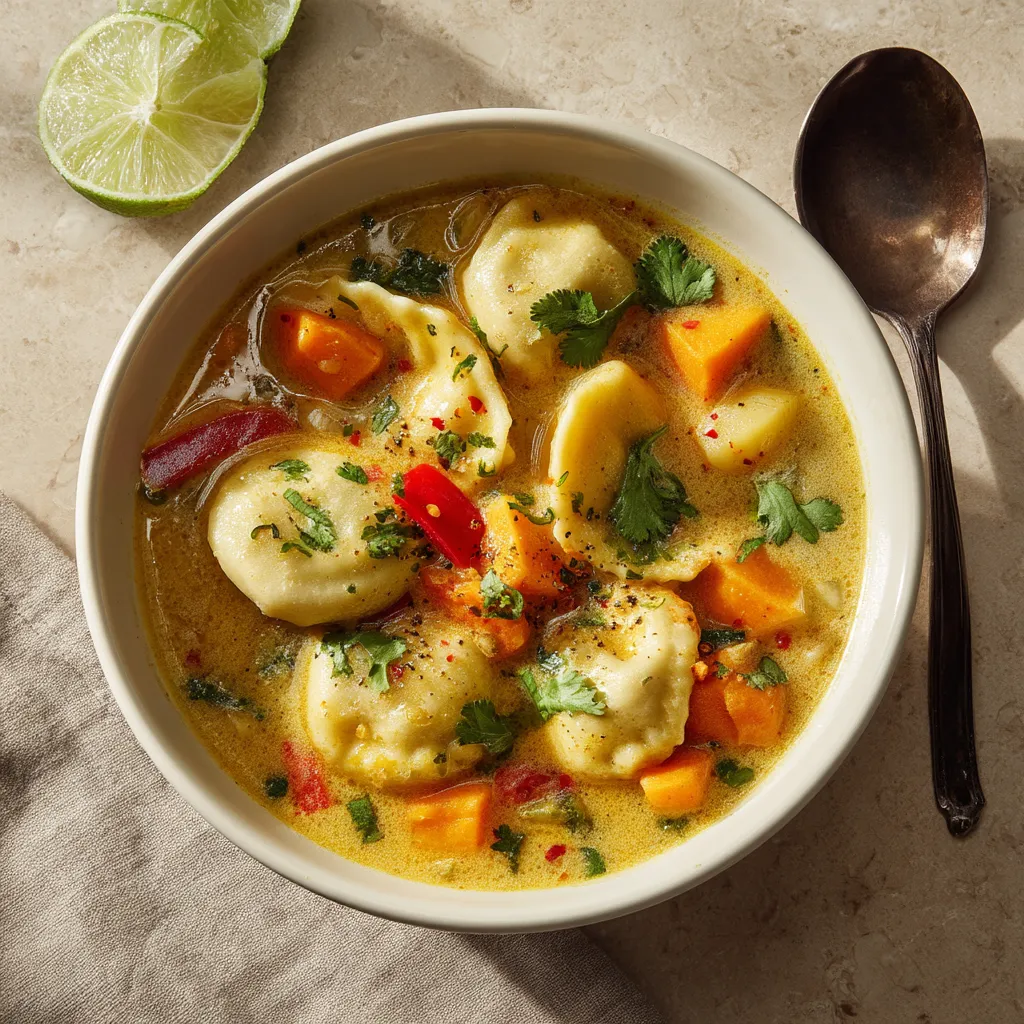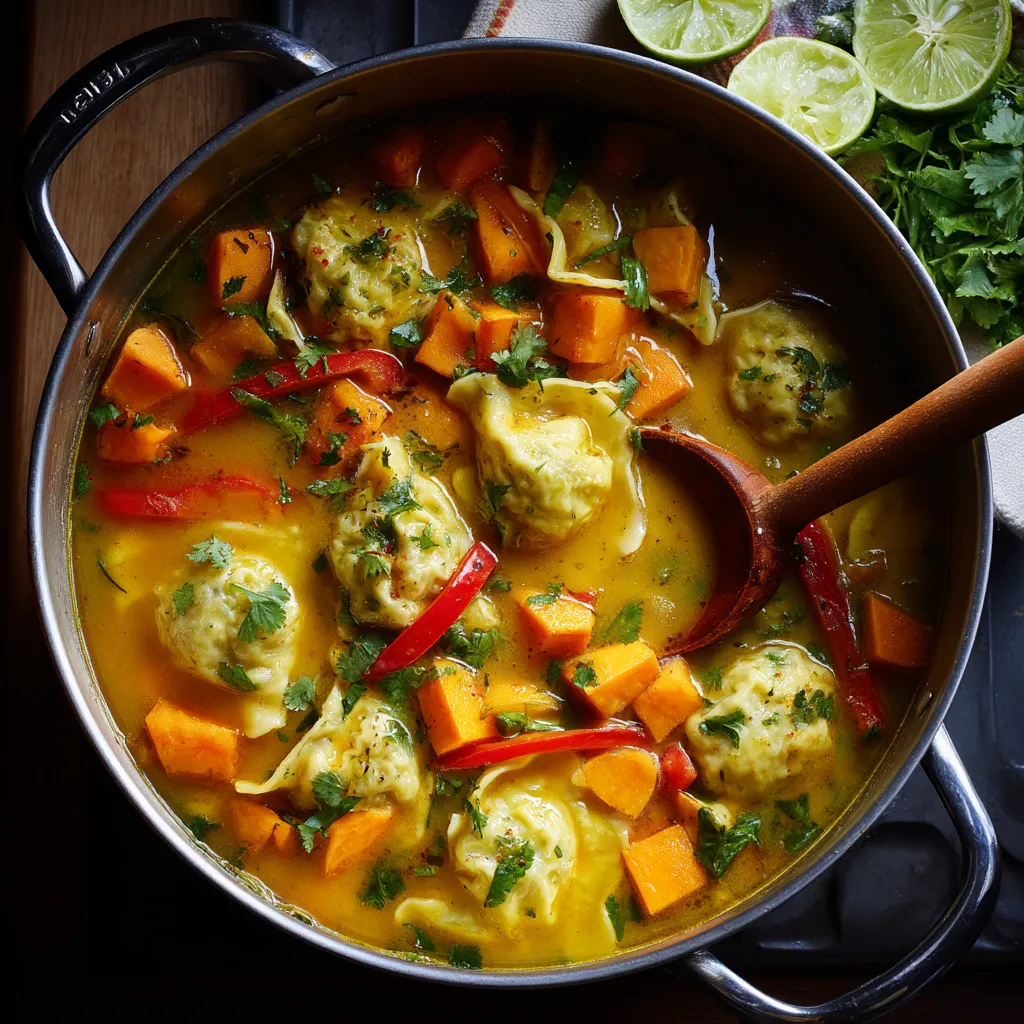 Save to Pinterest
Save to Pinterest This curry dumpling soup transforms ordinary ingredients into a soul-warming meal that balances rich flavors with comforting textures. The aromatic curry broth cradles handmade dumplings for a fusion dish that feels both adventurous and familiar, making it perfect for cozy dinners when you want something special without restaurant prices.
I created this recipe during a rainy weekend when I craved both the comfort of dumplings and the warmth of curry. After several refinements, it became my go-to dish for impressing guests who always assume it took hours to prepare.
Ingredients
- For the Dumplings Ground chicken or tofu forms the protein base that absorbs surrounding flavors
- Green onions add brightness that cuts through the rich broth
- Grated ginger infuses aromatic warmth that enhances the filling
- Sesame oil provides a nutty undertone that makes the dumplings distinctive
- Dumpling wrappers from the refrigerated section work perfectly look for ones with good pliability
- For the Curry Broth Yellow or red curry paste provides the flavor foundation choose yellow for milder heat or red for more intensity
- Sweet potato adds natural sweetness and hearty texture that balances the spices
- Coconut milk creates luxurious creaminess look for full-fat versions for best results
- Fresh lime juice brightens the entire dish with necessary acidity
- Vegetable or chicken broth determines the base flavor use homemade if available for superior results
Step-by-Step Instructions
- Prepare Dumpling Filling
- Combine ground chicken or tofu with aromatics and seasonings in a bowl. Mix thoroughly but gently to avoid overworking the protein. The mixture should hold together but still feel somewhat light. If using tofu, press it first to remove excess moisture for better texture.
- Form the Dumplings
- Place a small teaspoon of filling in the center of each wrapper. Resist overfilling which leads to bursting during cooking. Moisten the edges with water using your fingertip to create a seal. Fold the wrapper over to create a half-moon shape and press edges firmly to seal completely. For attractive presentation, create pleats along the sealed edge.
- Build Flavor Base
- Heat oil in a large pot over medium heat until it shimmers. Add onion, garlic and ginger, cooking until fragrant but not browned. This aromatic foundation permeates the entire soup with essential flavor compounds. Stir frequently to prevent burning.
- Develop the Curry Layer
- Add curry paste and cook briefly to bloom the spices. This crucial step activates the essential oils in the spices, dramatically enhancing their flavors. The paste should become fragrant and slightly darker as it cooks. If it appears dry, add a splash of broth.
- Cook the Vegetables
- Add sweet potato, carrot and bell pepper to the pot. Sauté until vegetables begin to soften slightly, allowing them to absorb the curry flavors. The vegetables should maintain some firmness at this stage as they will continue cooking in the broth.
- Create the Soup Base
- Pour in broth and bring to a gentle boil before reducing to a simmer. Allow the vegetables to cook until nearly tender, around 10 minutes. The broth will reduce slightly, concentrating flavors.
- Enrich the Broth
- Add coconut milk and soy sauce, stirring to integrate completely. The color will lighten to a creamy gold or orange. Taste and adjust salt now before adding dumplings. The broth should taste slightly stronger than desired as dumplings will absorb some flavor.
- Cook the Dumplings
- Carefully slide dumplings into the simmering broth one by one to prevent sticking. Ensure the broth maintains a gentle simmer not a rolling boil which could break apart the dumplings. Cook until they float to the surface and are cooked through completely.
- Finish and Serve
- Add lime juice just before serving to preserve its bright flavor. Ladle into bowls ensuring each serving gets plenty of vegetables and dumplings. Garnish generously with fresh cilantro and offer lime wedges alongside.
 Save to Pinterest
Save to Pinterest The sweet potato is my secret ingredient in this soup. While many curry soups use regular potatoes, the sweet variety adds a subtle natural sweetness that perfectly complements the spice profile. My daughter who typically avoids anything with the word "curry" requests this soup regularly, picking out the sweet potato cubes first before diving into the dumplings.
Make-Ahead Options
This soup works beautifully as a meal prep option. The broth actually improves after a day in the refrigerator as flavors meld and deepen. If planning ahead, consider making just the broth portion and refrigerating for up to three days. When ready to serve, reheat the broth and cook fresh dumplings directly in it. Alternatively, make the entire soup but keep the dumplings separate until reheating to prevent them from becoming soggy.
Customizing Your Curry Level
The beauty of this recipe lies in its adaptability to different spice preferences. For those who enjoy mild flavors, use yellow curry paste and reduce the amount to 1 tablespoon. For heat seekers, red curry paste provides more intensity, and you can increase to 3 tablespoons for significant heat. Additionally, adding a small chopped Thai chili with the garlic and ginger will elevate the spice level substantially. Remember that coconut milk helps temper heat, so adjust accordingly if making modifications.
Serving Suggestions
While this soup stands perfectly on its own as a complete meal, it pairs wonderfully with a few complementary sides. Consider serving with a simple cucumber salad dressed with rice vinegar to provide refreshing contrast to the rich soup. For hearty appetites, steamed jasmine rice on the side allows diners to create a more substantial meal. For entertaining, offer small bowls of additional garnishes like bean sprouts, fried shallots, or chopped peanuts to create an interactive dining experience where guests can customize their bowls.
Cultural Fusion Notes
This recipe represents a beautiful marriage between Chinese dumpling tradition and Southeast Asian curry flavors. While not strictly authentic to either cuisine, it respects the techniques and flavor principles of both. The dumpling preparation follows Chinese methods, while the curry broth incorporates Thai and Malaysian influences. This type of fusion cooking emerged in cosmopolitan Asian cities where culinary boundaries blur naturally, creating new traditions that honor their origins while embracing innovation.
 Save to Pinterest
Save to Pinterest Common Recipe Questions
- → Can I make this soup ahead of time?
Yes! Make the broth and refrigerate for up to 2 days. Prepare the dumplings separately and store uncooked, covered with plastic wrap. When ready to serve, reheat the broth, then cook the dumplings directly in the hot broth for 6-8 minutes before serving.
- → What's the best way to seal dumplings properly?
Place filling in the center of each wrapper, then moisten the entire edge with water. Fold in half and press firmly to seal. For a decorative edge, create pleats by folding small sections of the edge as you seal. Ensure there are no gaps to prevent filling from leaking during cooking.
- → Can I freeze leftover soup?
The broth freezes well, but cooked dumplings may become mushy when thawed. For best results, freeze only the broth portion and make fresh dumplings when reheating. Alternatively, freeze uncooked dumplings separately on a baking sheet before transferring to a container.
- → What type of curry paste works best?
Both yellow and red curry paste work well. Yellow curry offers a milder, more aromatic profile with turmeric notes, while red curry provides a bolder, spicier flavor. Adjust quantity based on your heat preference and the specific brand of curry paste you're using.
- → How can I make this more substantial for a main dish?
Add more protein by increasing the dumpling count or adding cubed tofu or chicken directly to the broth. Include additional vegetables like mushrooms, snow peas, or baby corn. Serve with steamed rice or noodles on the side for a heartier meal that will satisfy bigger appetites.
- → What's a good substitute for coconut milk?
For a lighter option, use half coconut milk and half broth. Alternatively, cashew cream provides similar richness without the coconut flavor. In a pinch, unsweetened almond milk with a tablespoon of cornstarch can mimic the thickness, though the flavor profile will be different.